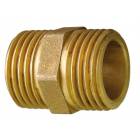Gnali Bocia: design of brass fittings
Brass fittings are used to connect different parts together, allowing gas and liquid to flow through.

Brass fittings are designed, checked and marketed by Gnali Bocia which guarantees all the features and reject any components having slight defects either on the surface or in their microstructure.
The fittings are made of brass, a metal alloy made up of copper and zinc.
Brass is used due to its unique combination of properties together with the low costs of its manufacture which are even lower than those of steel. These factors make brass suitable for the design of fittings.
The types of brass alloys are different and vary on the basis of the content of the added alloy elements. Generally, the zinc content of the alloy never exceeds 50% because when the zinc increases, alloys with different phases are formed, that is to say, with extremely incompatible microstructures and characteristics: an excess of zinc may lead to the formation of a so called “gamma phase” which from a design point of view is absolutely not suitable. There are other types of brass used for the fittings, including leaded brass which is so called because the average lead used is equal to 3%. This element favours machine tool production since the Pb is arranged along the grain boundaries of the alloy – the boundaries of the formed microstructures – helping breakage.
Other types of brass can be used to produce fittings, including different alloy elements such as magnesium, iron, tin, aluminium, nickel and silicon. As with all the alloy elements, it is important to adhere to preset percentages in order to obtain fittings with features as close to the ideal ones as possible.
The fittings are made of brass, a metal alloy made up of copper and zinc.
Brass is used due to its unique combination of properties together with the low costs of its manufacture which are even lower than those of steel. These factors make brass suitable for the design of fittings.
The types of brass alloys are different and vary on the basis of the content of the added alloy elements. Generally, the zinc content of the alloy never exceeds 50% because when the zinc increases, alloys with different phases are formed, that is to say, with extremely incompatible microstructures and characteristics: an excess of zinc may lead to the formation of a so called “gamma phase” which from a design point of view is absolutely not suitable. There are other types of brass used for the fittings, including leaded brass which is so called because the average lead used is equal to 3%. This element favours machine tool production since the Pb is arranged along the grain boundaries of the alloy – the boundaries of the formed microstructures – helping breakage.
Other types of brass can be used to produce fittings, including different alloy elements such as magnesium, iron, tin, aluminium, nickel and silicon. As with all the alloy elements, it is important to adhere to preset percentages in order to obtain fittings with features as close to the ideal ones as possible.
23/01/2013
I contenuti di questo sito non hanno carattere di periodicità e non rappresentano 'prodotto editoriale'.








